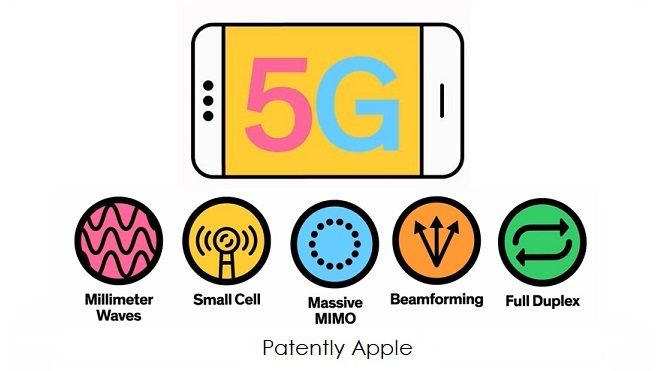Patently Apple posted a report in late August titled "An Apple-Euro Patent Covers a Next-Gen Millimeter-Wave Yagi Antenna for iPhone, Smart Glasses, TV & More." The report also covered the fact that Apple had sought a license from the FCC covering new wireless Millimeter Wave technology and more. Today the US Patent & Trademark Office published Apple's first yagi antenna patent. Millimeter wave antennas are likely to surface when Apple delivers iDevices that are designed for next generation 5G networks that should roll out in the U.S. sometime between 2020 and 2021 if all goes well. The video below explains why Millimeter Wave technology is going to be important.
The problem with Millimeter Wave technology, as presented in the video, is the focus of Apple's invention to overcome via yagi antennas.
Apple notes in their patent background that it may be desirable to support wireless communications in millimeter wave communications bands. Millimeter wave communications, which are sometimes referred to as extremely high frequency (EHF) communications, involve communications at frequencies of about 10-400 GHz.
Operation at these frequencies may support high bandwidths, but may raise significant challenges. For example, millimeter wave communications are often line-of-sight communications and can be characterized by substantial attenuation during signal propagation.
It would therefore be desirable to be able to provide electronic devices with improved wireless communications circuitry such as communications circuitry that supports millimeter wave communications.
Apple's invention covers an electronic device that may be provided with wireless circuitry. The wireless circuitry may include one or more antennas. The antennas may include phased antenna arrays each of which includes multiple antenna elements. The phased antenna arrays may be used to handle millimeter wave wireless communications and may perform beam steering operations.
Antennas such as antennas in phased antenna arrays may be mounted at the corners of a housing for the electronic device or elsewhere in an electronic device. The antennas may be printed circuit board antennas formed from patterned metal traces on printed circuit board substrates.
The printed circuit board antennas may include Yagi antennas. Each Yagi antenna may have a reflector, a radiator, and one or more directors. The electronic device may have a metal housing with dielectric regions. The dielectric regions may be plastic-filled slots in the metal housing or other dielectric areas.
The reflector, radiator, and directors may be configured so that each antenna has a radiation pattern that is aligned with a respective portion of the dielectric in the metal housing. In printed circuit boards with multiple substrate layers, different directors in an antenna may be embedded between different respective pairs of the substrate layers to form vertically oriented or diagonally oriented radiation patterns. The directors of an antenna may also be formed along the surface of a printed circuit board so that the antenna exhibits a horizontally oriented radiation pattern.
Antennas #40 illustrated in Patent FIG. 6 may be Yagi printed circuit board antennas and/or other suitable antennas.
Further, Apple patent FIG. 6 is a rear view of an iDevice in an illustrative configuration in which each corner #50 has been provided with a phased antenna array formed from multiple antennas. In the example of FIG. 6, each corner has an array formed from three respective antennas 40 oriented at 0.degree., 45.degree., and 90.degree. so that adjacent antennas have radiation patterns that are oriented in directions separated by 45.degree., but the antenna array at each corner may have any suitable number of antennas (e.g., two or more, three or more, four or more, five or more six or more, two to five, three to five, three to eight, fewer than five, fewer than ten, etc.) and these antennas may be separated by any suitable angular amount (0-45.degree., 10-30.degree., more than 5.degree., less than 25.degree., less than 75.degree., etc.).
For more details, see Apple's patent application 20170309991 which was filed back in Q2 2016. Considering that this is a patent application, the timing of such a product to market is unknown at this time – though it's probably being considered when 5G networks arrive in the next few years.
Images, video and contents appeared are from Youtube, Apple, IEEE Spectrum and Patently Apple
